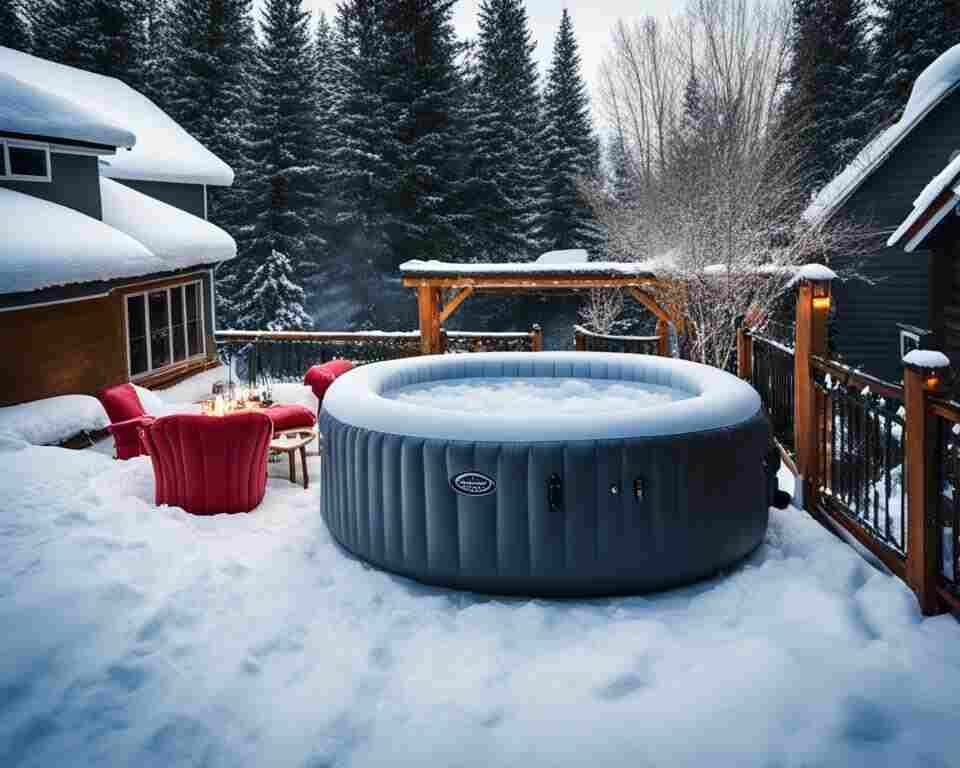Hello, fellow hot tub enthusiasts! If you’re wondering whether inflatable hot tubs can be used in the winter, you’ve come to the right place. As a dedicated winter hot tub aficionado, I’m here to share my knowledge and experiences with you.
When the temperatures drop and snowflakes start falling, there’s nothing quite like immersing oneself in the soothing warmth of a hot tub. But can inflatable hot tubs withstand the cold and provide that winter bliss we all crave? Let’s dive in and find out!
Key Takeaways:
- Inflatable hot tubs can indeed be used in the winter, with proper preparation and maintenance.
- Understanding how these hot tubs function in low temperatures and the importance of insulation is crucial.
- Preparing your inflatable hot tub for winter use is essential for maintaining heat and preventing freezing.
- Using weather-resistant materials and insulated covers can help ensure the longevity and performance of your hot tub.
- Enjoy the unique benefits of winter hot tubbing, including relaxation, stress relief, and a magical winter experience.

Can You Use Inflatable Hot Tubs in Winter?
Yes, you can use inflatable hot tubs in winter. Ensure winterization with proper insulation, a secure cover, and temperature regulation for a comfortable and enjoyable experience during colder months.
The Basics of Using Inflatable Hot Tubs in Cold Weather
When it comes to enjoying a relaxing soak in an inflatable hot tub during the winter, many people wonder if these portable spas can withstand freezing temperatures and provide the same level of comfort as traditional hot tubs.
In this section, we will dive into the basics of using inflatable hot tubs in cold weather and explore their functionality, insulation, and proper winter maintenance.
How Inflatable Hot Tubs Function in Low Temperatures
Inflatable hot tubs are designed to operate in a wide range of temperatures, including freezing conditions. The materials used in their construction are specifically chosen for their durability and resistance to extreme weather. They are typically made from reinforced PVC or a similar weather-resistant material that can withstand the cold without losing its structural integrity.
These hot tubs feature built-in heating systems that are capable of maintaining the desired water temperature even in freezing temperatures. The heating element is usually electric and incorporates advanced technology to efficiently warm up the water and keep it at a comfortable level.
It’s worth noting that the efficiency of the heating system can be affected by extremely low temperatures, as the unit may need to work harder to combat the cold. However, with proper insulation and maintenance, inflatable hot tubs can still provide a cozy and inviting environment for winter relaxation.
The Importance of Insulation and Heat Retention
Insulation is a crucial aspect of using inflatable hot tubs in cold weather. Adequate insulation helps to minimize heat loss and retain the warmth of the water, ensuring a comfortable soak even in freezing temperatures.
Many inflatable hot tubs are equipped with insulating materials or air chambers that help to trap heat inside the tub. This insulation not only keeps the water warm but also reduces energy consumption by minimizing heat dissipation.

Proper Preparation for Winter Use
To ensure optimal performance and longevity of your inflatable hot tub during the winter months, it’s important to take certain precautions and follow winter maintenance tips.
- Before setting up your hot tub, choose a suitable location that offers protection from cold winds and maximizes exposure to sunlight.
- Consider investing in an insulated cover specifically designed for cold weather use. This cover can help to retain heat, reduce energy consumption, and prevent debris from entering the tub.
- Regularly check and clean the filter to ensure proper water circulation and filtration.
- Monitor the water chemistry closely and adjust the chemical levels accordingly to maintain water balance.
- When not in use, it’s essential to drain and store the hot tub properly to prevent freezing and damage to the components.
By following these winterizing tips and paying attention to regular maintenance, you can enjoy the benefits of your inflatable hot tub even in the coldest months of the year.
| Benefits of Using Inflatable Hot Tubs in Winter | Winter Maintenance for Inflatable Hot Tubs |
|---|---|
| 1. Relaxation and stress relief | 1. Protecting your hot tub from freezing temperatures |
| 2. Unique winter experience | 2. Best practices for consistent heating |
| 3. Enjoyment of winter hot tubbing with inflatable spas | 3. Weather-resistant materials and insulated covers |
Embracing the Chill: Benefits of Using Inflatable Hot Tubs in Winter
When the temperature drops and winter sets in, many people assume that hot tub use is exclusively a warm-weather activity. However, inflatable hot tubs can provide a delightful and rejuvenating experience even during the coldest months of the year. In fact, there are several compelling benefits to using inflatable hot tubs in winter.
One of the key advantages of enjoying a hot tub soak in winter is the relaxation it offers. The warm water and soothing jets provide a perfect environment to unwind and relieve the stress that accumulates during the colder months. The combination of warm water and hydrotherapy can help relax muscles, ease tension, and promote overall well-being.
In addition to relaxation, using an inflatable hot tub in winter can also provide unique sensory experiences. Imagine immersing yourself in the warm water while brisk winter air surrounds you. The contrast of the elements creates a delightful and invigorating sensation, awakening your senses and enhancing the overall hot tub experience.
Winter hot tubbing can also be a great way to reconnect with nature. Imagine sitting in your inflatable hot tub, steam rising into the crisp winter air, and gazing at the snow-covered landscape. It’s a serene and peaceful experience that allows you to enjoy the beauty of winter while staying cozy and warm in the comfort of your hot tub.
Furthermore, winter hot tub use allows you to fully maximize your investment in an inflatable spa. Instead of limiting your enjoyment to a few months of the year, using your hot tub in winter ensures that you get the most out of it all year round.
Plus, with advancements in technology and insulation, inflatable hot tubs can maintain heat efficiently even in freezing temperatures, allowing you to enjoy your spa experience without worrying about cold water or discomfort.
In conclusion, investing in an inflatable hot tub opens up a world of benefits and experiences, even during the chilly winter months. From relaxation and stress relief to unique sensory experiences and reconnecting with nature, the advantages of winter hot tubbing are plentiful.
So, don’t let the cold weather deter you – embrace the chill and enjoy the blissful world of inflatable hot tubs.
Winter Maintenance for Inflatable Hot Tubs
In this section, I will discuss the importance of winter maintenance for inflatable hot tubs to ensure optimal performance and longevity. Proper care during the colder months is essential to protect your hot tub from freezing temperatures and maintain consistent heating.
Additionally, the use of weather-resistant materials and insulated covers plays a crucial role in safeguarding your hot tub from the harsh winter elements.
Protecting Your Hot Tub from Freezing Temperatures
Freezing temperatures can cause significant damage to inflatable hot tubs if not properly addressed. To protect your hot tub, follow these best practices:
- Keep your hot tub running, even when not in use, to prevent the water from freezing.
- Ensure that all pipes and fittings are insulated to minimize the risk of freezing.
- Use a freeze protection system or a freeze-resistant plumbing setup to safeguard your hot tub from extreme temperatures.
- Set up an automated temperature monitor and alarm system to alert you if the water temperature drops to a dangerous level.
Best Practices for Consistent Heating
Maintaining consistent heating in your inflatable hot tub is crucial for a pleasant and enjoyable winter experience. Here are some best practices to ensure optimal heat retention:
- Regularly check and clean your hot tub’s heating element to remove any debris or buildup that may impede its function.
- Optimize insulation by using a thermal floating blanket or cover to trap heat and prevent heat loss from the water’s surface.
- Avoid keeping the hot tub lid open for extended periods, as it allows heat to escape.
- Consider using an energy-efficient hot tub heater or heat pump designed for winter use to minimize energy consumption without compromising heat output.
Weather-Resistant Materials and Insulated Covers
Investing in quality, weather-resistant materials for your inflatable hot tub is essential for its durability and long-term performance. Additionally, using an insulated cover is crucial for maintaining heat and protecting the hot tub from snow, ice, and other winter elements.

By following these winter maintenance best practices, you can enjoy your inflatable hot tub throughout the colder months with peace of mind.
Can You Use Inflatable Hot Tubs in the Winter
In this section, we will address the question of whether inflatable hot tubs can be used in the winter. Many people wonder if these portable and easy-to-set-up hot tubs can withstand freezing temperatures.
Let’s explore the challenges they may face in freezing weather and discover strategies for successful winter hot tubbing with inflatable models.
Assessing the Challenges of Inflatable Hot Tubs in Freezing Weather
Using inflatable hot tubs during winter months poses certain challenges due to the low temperatures. One of the main concerns is maintaining heat and preventing freezing. Due to their lightweight nature, inflatable hot tubs may experience faster heat loss compared to traditional built-in models.
When ambient temperatures drop, the water inside the tub can cool rapidly, resulting in a less comfortable hot tubbing experience.
Additionally, freezing temperatures can potentially cause damage to the inflatable walls and plumbing of the hot tub. If the water inside the tub freezes, it can expand and lead to ruptures or leaks.
Preventing freezing is crucial to ensure the longevity and functionality of the inflatable hot tub during the winter.
Strategies for Successful Winter Hot Tubbing with Inflatable Models
Fortunately, there are several strategies and tips to overcome the challenges and enjoy a safe and enjoyable hot tub experience during the colder months:
- Start with well-insulated models: Look for inflatable hot tubs specifically designed for winter use, as they often feature enhanced insulation to prevent heat loss.
- Choose a suitable location: Place the hot tub in a sheltered area, away from harsh winds and drafts. This can help minimize heat loss and maintain a comfortable water temperature.
- Invest in an insulated cover: An insulated cover acts as a protective barrier, helping to retain heat and prevent the water from freezing. Use the cover whenever the hot tub is not in use.
- Consider additional insulation: In colder climates or during prolonged freezing temperatures, you may want to add extra insulation around the hot tub. This can be achieved using foam boards or thermal blankets.
- Use winter accessories: Consider using thermal blankets or floating foam covers to further insulate the water surface and reduce heat loss.
- Maintain proper water chemistry: It’s crucial to regularly check and balance the water chemistry in your inflatable hot tub. Cold weather can affect the chemical balance, so monitoring and adjusting the levels appropriately is essential.

Winter Hot Tub Maintenance
In addition to the strategies mentioned, proper winter hot tub maintenance is key to ensuring the longevity and optimal performance of inflatable models. Regularly check for any signs of damage or leaks, and promptly address them to prevent further issues.
It’s also important to have a reliable water testing kit and follow a routine maintenance schedule to keep the water clean and sanitized throughout the winter season.
| Winter Tips for Using Inflatable Hot Tubs |
|---|
| Start with well-insulated models |
| Choose a suitable location |
| Invest in an insulated cover |
| Consider additional insulation |
| Use winter accessories |
| Maintain proper water chemistry |
Conclusion
In conclusion, inflatable hot tubs can indeed be used in winter with proper preparation and maintenance. Despite the cold weather, these portable hot tubs can provide a blissful experience during the colder months. By following the best practices and implementing winter maintenance strategies, you can enjoy the benefits of winter-friendly inflatable hot tubs.
Throughout this article, we have discussed the functionality of inflatable hot tubs in low temperatures and the importance of insulation and heat retention. We have also provided tips for properly preparing and maintaining your hot tub for winter use. By utilizing weather-resistant materials and insulated covers, you can protect your inflatable hot tub from freezing temperatures.
When it comes to choosing the best inflatable hot tubs for winter, there are several trusted brands to consider. Brands like Intex and Coleman offer winter-friendly models that are specifically designed to withstand colder temperatures. These models often feature enhanced insulation and robust construction, making them ideal for winter hot tubbing.
In summary, while using inflatable hot tubs in winter requires some extra care and attention, they can provide an enjoyable and relaxing experience. By investing in a winter-friendly model and following the maintenance guidelines, you can create your own winter hot tub bliss and make the most of the chilly months.
FAQ
How do inflatable hot tubs function in low temperatures?
Inflatable hot tubs are designed to maintain heat even in low temperatures. They are equipped with a heating system that warms the water and keeps it at the desired temperature. The heater works in conjunction with the insulation and heat retention properties of the hot tub to prevent heat loss.
Why is insulation and heat retention important for inflatable hot tubs in winter?
Insulation and heat retention are crucial for inflatable hot tubs in winter because they help retain the warmth of the water. The insulation minimizes heat loss and ensures that the water stays hot for longer periods. Heat retention is particularly important during colder months to maintain a comfortable temperature in the hot tub.
How should I prepare my inflatable hot tub for winter use?
To properly prepare your inflatable hot tub for winter use, start by ensuring that it is clean and free from debris. Make sure all the components, such as the heater and filtration system, are in good working condition. Additionally, consider using weather-resistant materials for the surroundings and investing in an insulated cover to help retain heat.
What are the benefits of using inflatable hot tubs in the winter?
Using inflatable hot tubs in the winter offers a range of benefits. It provides relaxation and stress relief, especially during the colder months. Enjoying a hot tub soak in winter can be a unique experience, allowing you to embrace the chill while staying warm and cozy. Winter hot tubbing with inflatable spas can also bring a sense of bliss and rejuvenation.
How do I protect my inflatable hot tub from freezing temperatures?
To protect your inflatable hot tub from freezing temperatures, it’s important to follow proper winter maintenance practices. These include insulating the bottom of the hot tub, using a thermal blanket or floating insulation, and covering the hot tub with an insulated cover when not in use. Regularly checking and maintaining the water temperature is also essential.
What are the best practices for consistent heating in an inflatable hot tub during winter?
To ensure consistent heating in an inflatable hot tub during winter, it’s important to keep the hot tub covered when not in use. This helps retain heat and prevents heat loss. Regularly check the water temperature and adjust the heater if necessary. Additionally, be mindful of cold drafts and avoid leaving the hot tub uncovered for extended periods.
Are there any weather-resistant materials and insulated covers available for inflatable hot tubs?
Yes, there are weather-resistant materials and insulated covers available specifically for inflatable hot tubs. These materials are designed to withstand cold weather and help retain heat in the hot tub. Investing in a high-quality insulated cover can greatly enhance the winter experience and improve the overall efficiency of the hot tub.
What are the challenges of using inflatable hot tubs in freezing weather?
Using inflatable hot tubs in freezing weather presents a few challenges. The main challenge is maintaining heat and preventing freezing. Without proper insulation and heat retention, the hot tub water may cool down faster, and the risk of freezing becomes higher. However, with the right preparations and maintenance, these challenges can be overcome.
What strategies can I employ for successful winter hot tubbing with inflatable models?
To ensure successful winter hot tubbing with inflatable models, start by properly winterizing the hot tub. Use weather-resistant materials for the surroundings and an insulated cover to retain heat. Regularly monitor and adjust the water temperature as needed. Avoid leaving the hot tub uncovered for extended periods and take care to prevent freezing.

